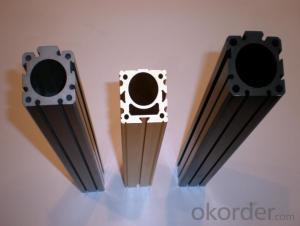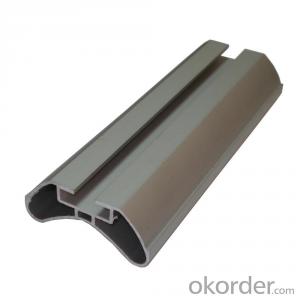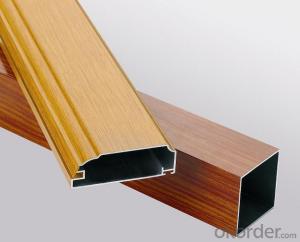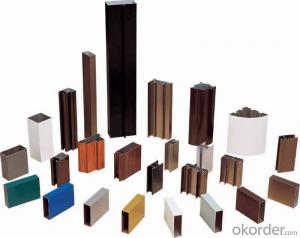window and door aluminium profile
- Loading Port:
- China Main Port
- Payment Terms:
- TT OR LC
- Min Order Qty:
- -
- Supply Capability:
- -
OKorder Service Pledge
Quality Product, Order Online Tracking, Timely Delivery
OKorder Financial Service
Credit Rating, Credit Services, Credit Purchasing
You Might Also Like
Aluminium profile
1) Alloy: AA6061, AA6063
2) Temper: T5, T6
3) Series of surface treament:
1. Mill Finished
2. Anodizing: Silver, champagne, light bronze, dark bronze, black, light titanium, dark titanium.
3. Electrophoretic Coating: Silver, champagne, bronze, black, light bronze, dark bronze.
4. Electrostatic Color Powder Coating: Normal color, special color.
5. Fluorocarbon Powder Spraying: Normal color, special color.
6. Wood Grain Coating: Import paper, domestic paper.

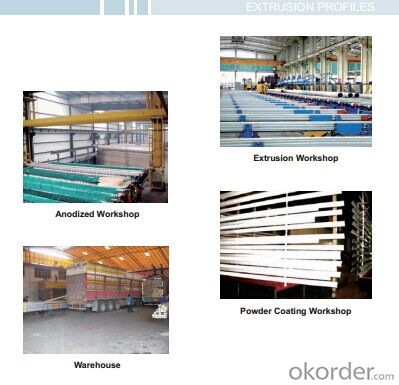
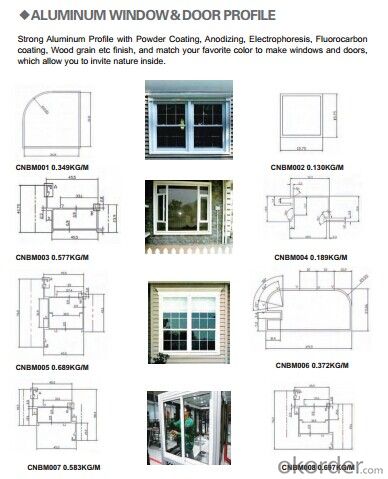
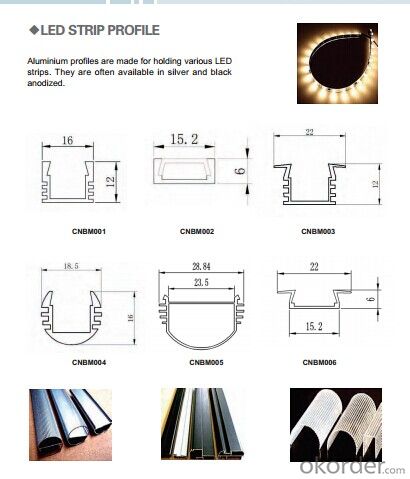

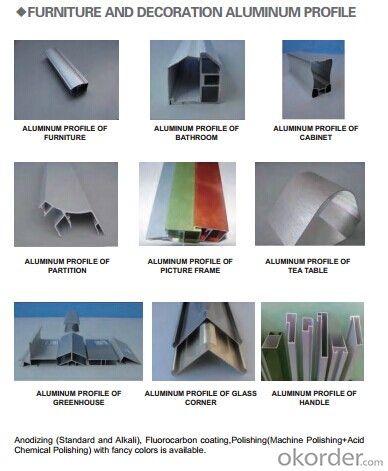
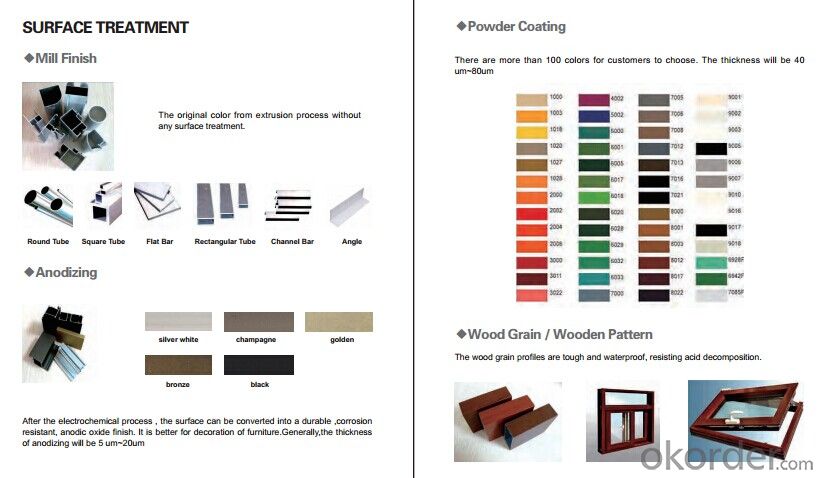
- Q:What is aluminum profile opening mold, I want to process a batch of aluminum profiles, the other side to open mold fees also expensive, then I can open the mold of things? I don't know the hero for a favor
- Aluminum production process is actually like toothpaste, the liquid aluminum from a specific shape of the mouth squeezed out, cool after becoming a profile, mold that is to do that exit......
- Q:How do aluminum profiles contribute to energy-saving initiatives?
- Aluminum profiles contribute to energy-saving initiatives in several ways. Firstly, aluminum is a lightweight and durable material, making it an ideal choice for constructing energy-efficient buildings and structures. The use of aluminum profiles in windows and doors helps to improve insulation and reduce heat transfer, thereby reducing energy consumption for heating and cooling. Additionally, aluminum profiles are often used in the manufacturing of solar panels, as their lightweight nature allows for easier installation and transportation. This promotes the use of renewable energy sources and reduces reliance on fossil fuels. Overall, aluminum profiles play a significant role in enhancing energy efficiency and promoting sustainability in various industries.
- Q:What is the material content of 4040 aluminum alloy profiles?
- Aluminium alloy grade: 6063Silicon (Si) 0.2-0.6%,Iron (Fe) 0.35%,Copper (Cu) 0.1%,Manganese (Mn) 0.1%,Magnesium (Mg) 0.45-0.9%,Chromium (Cr) 0.1%,Zinc (Zn) 0.1%,Titanium (Ti) 0.1%Other metals accounted for 0.15% of the total,Aluminum (Al) 97.35--98.35%Shanghai Australia Hong Industrial Aluminum Co., Ltd. specializes in providing1. mold development and design2. extrusion of industrial aluminum extrusions3. industrial aluminum parts4. industrial aluminum profiles and assembly lines, tables, transmission line equipment development and installation
- Q:How do aluminum profiles contribute to daylighting strategies?
- Aluminum profiles contribute to daylighting strategies by being used in the construction of windows, doors, and skylights. These profiles are designed to be lightweight, durable, and have excellent thermal properties. They allow for larger glass panels, maximizing the amount of natural light that enters a space. Additionally, the profiles can be customized to accommodate different glazing options, such as low-emissivity coatings or solar control films, which help regulate heat gain and loss. Overall, aluminum profiles enhance daylighting strategies by promoting the use of natural light, reducing reliance on artificial lighting, and improving energy efficiency in buildings.
- Q:How can I control the hardness of 6063 aluminum profile at 6-9 degrees?
- Classification: extension material, non heat treatment alloy and heat treatment alloy1.1 non heat treated alloys: pure aluminum - 1000 series, Al Mn alloy - 3000 series, Al Si alloy - 4000 series, Al Mg alloy - 5000 Series1.2 heat treatment of Al Cu Mg alloy alloy: 2000, aluminum magnesium silicon alloy - 6000 series aluminium zinc magnesium alloy - 7000.Two, alloy number: China's current general is the American Aluminum Association "Aluminium Association" numberExamples are as follows: 1070-H14 (pure aluminum)2017-T4 (heat treatment alloy)3004-H32 (non heat treated alloy)2.1 first digit: indicates the main addition of alloying elements1: pure aluminum2: the main alloy element added copper3: the main alloying elements are manganese or manganese and magnesium4: the main alloy element is added silicon5: the main alloying element is magnesium6: mainly add alloy elements for silicon and magnesium7: the main alloying elements are zinc and magnesium8: a new alloy that does not belong to the above alloy series2.2, second digits: an alloy that indicates the addition of alloying elements or impurities in the original alloy0: table alloy1: table original alloy by the first amendment2: table original alloy after second modifications2.3, third, and four digits:Pure aluminum: represents the original alloyAlloy: the designation of individual alloys"- >: the back of Hn or Tn indicates the condition of work hardening or the symbol of heat treatment state-Hn: indicating the symbol for non heat treated alloys-Tn: a symbol for heat treatment alloysHeat treatment of 2 aluminium and aluminium alloyA chain symbol: if the alloy element is added, it is not enough to meet the requirements, but still needs cold processing, quenching and agingTreatment and soft burning to obtain the required strength and performanceAs a result of quenching and tempering, the result of quenching and tempering is chain
- Q:Can aluminum profiles be an alternative to steel in certain applications?
- Yes, aluminum profiles can be a viable alternative to steel in certain applications. Aluminum profiles offer several advantages over steel, making them suitable for specific use cases. Firstly, aluminum profiles are much lighter than steel, which can be advantageous in industries where weight reduction is critical, such as aerospace or automotive applications. The lower weight of aluminum profiles also makes them easier to handle and install in various construction projects. Secondly, aluminum profiles have excellent corrosion resistance properties. Unlike steel, which is susceptible to rust and corrosion, aluminum naturally forms a protective oxide layer on its surface, providing long-term protection against environmental elements. This makes aluminum profiles a preferred choice in outdoor applications or environments with high humidity or exposure to chemicals. Additionally, aluminum profiles have a higher strength-to-weight ratio compared to steel. Although steel is generally stronger, aluminum profiles can still provide sufficient strength for many applications while being significantly lighter. This characteristic makes aluminum profiles suitable for structures that require high strength but need to be lightweight, such as building facades or bridges. Furthermore, aluminum profiles have superior thermal conductivity compared to steel. This makes them an excellent choice for applications that require efficient heat dissipation or thermal management, such as heatsinks or heat exchangers. In conclusion, while steel remains the preferred choice in many applications due to its strength, aluminum profiles can be a viable alternative in certain situations. Their lightweight nature, corrosion resistance, high strength-to-weight ratio, and thermal conductivity make them ideal for specific industries and projects.
- Q:What are the advantages of using aluminum profiles in the automotive aftermarket?
- Using aluminum profiles in the automotive aftermarket comes with several advantages. To begin with, aluminum profiles are both lightweight and strong, making them ideal for automotive applications. By opting for aluminum profiles instead of traditional steel or other heavy materials, vehicles can be made lighter. This results in improved fuel efficiency and reduced emissions, which is especially important in today's environmentally conscious world. Moreover, aluminum profiles provide excellent corrosion resistance. This is crucial for automotive parts that are exposed to various weather conditions and road salt. Unlike steel, aluminum does not rust, ensuring durability and longevity for aftermarket automotive components. Additionally, aluminum profiles offer great flexibility and can be easily customized and shaped to meet specific design requirements. This allows for the creation of complex and intricate designs that enhance both the aesthetics and functionality of aftermarket automotive parts. Whether it's body panels, interior trim, or structural components, aluminum profiles can be tailored effortlessly to meet the unique needs of each vehicle. Furthermore, aluminum profiles boast excellent thermal conductivity. This means they efficiently dissipate heat, making them suitable for applications such as heat exchangers or cooling systems in the automotive aftermarket. This property helps prevent overheating and ensures optimal vehicle performance. Lastly, aluminum is highly recyclable, making it a sustainable choice for the automotive aftermarket. By using aluminum profiles, manufacturers and consumers can actively contribute to reducing waste and minimizing environmental impact. Participating in the circular economy by recycling and reusing aluminum profiles helps decrease the overall carbon footprint. In conclusion, the advantages of utilizing aluminum profiles in the automotive aftermarket are evident. From weight reduction and improved fuel efficiency to corrosion resistance, customizability, thermal conductivity, and sustainability, aluminum profiles offer numerous benefits that make them an excellent choice for aftermarket automotive components.
- Q:Is the aluminum profile insulated and broken hot?
- Yes, the name is not the same, the professional name is "broken hot aluminum alloy", most people used to call "broken bridge aluminum"
- Q:How do aluminum profiles handle extreme weather conditions?
- Aluminum profiles are known for their excellent resistance to extreme weather conditions. Due to their inherent corrosion resistance, they can withstand exposure to rain, snow, UV radiation, and high temperatures without deteriorating or losing their structural integrity. Additionally, aluminum profiles have a low thermal expansion coefficient, making them highly stable and resistant to warping or cracking in extreme temperature fluctuations. Overall, aluminum profiles are a reliable choice for outdoor applications, as they can handle a wide range of weather conditions with minimal maintenance.
- Q:Are aluminum profiles suitable for automotive racks and carriers?
- Aluminum profiles, indeed, possess the appropriateness for automotive racks and carriers. Being both lightweight and robust, aluminum emerges as an optimal material for instances that prioritize weight reduction, such as automotive racks and carriers. The adaptability and flexibility of aluminum profiles enable their design and engineering to cater to specific requirements, facilitating customization. Besides, aluminum's resistance to corrosion guarantees the endurance and long-lasting nature of automotive racks and carriers, even in unfavorable weather conditions. Moreover, the notable strength-to-weight ratio of this material contributes to an enhanced fuel efficiency and reduced emissions. In summary, aluminum profiles furnish a dependable and efficient resolution for automotive racks and carriers.
1. Manufacturer Overview |
|
|---|---|
| Location | |
| Year Established | |
| Annual Output Value | |
| Main Markets | |
| Company Certifications | |
2. Manufacturer Certificates |
|
|---|---|
| a) Certification Name | |
| Range | |
| Reference | |
| Validity Period | |
3. Manufacturer Capability |
|
|---|---|
| a)Trade Capacity | |
| Nearest Port | |
| Export Percentage | |
| No.of Employees in Trade Department | |
| Language Spoken: | |
| b)Factory Information | |
| Factory Size: | |
| No. of Production Lines | |
| Contract Manufacturing | |
| Product Price Range | |
Send your message to us
window and door aluminium profile
- Loading Port:
- China Main Port
- Payment Terms:
- TT OR LC
- Min Order Qty:
- -
- Supply Capability:
- -
OKorder Service Pledge
Quality Product, Order Online Tracking, Timely Delivery
OKorder Financial Service
Credit Rating, Credit Services, Credit Purchasing
Similar products
New products
Hot products
Related keywords
